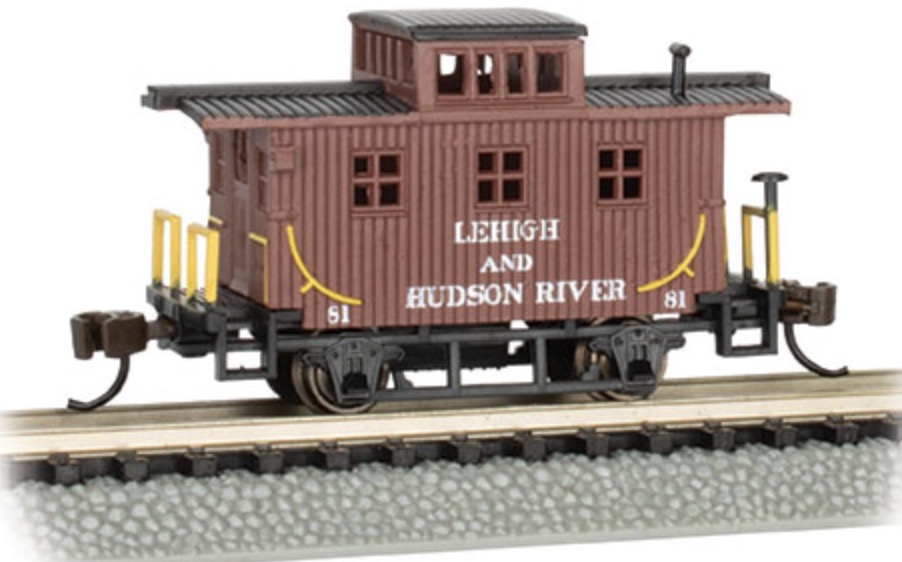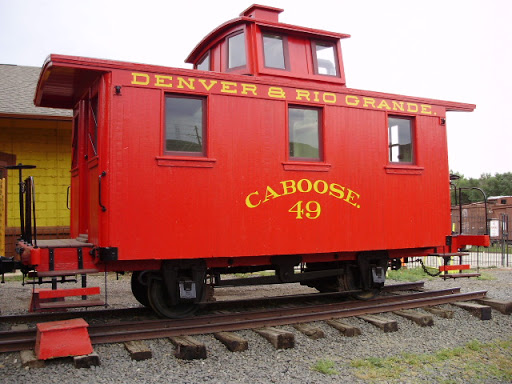Prototype History: The humble caboose was a fixture on the end of freight trains for more than a century. The name may have originated with a French or Dutch word describing a deck cabin on a sailing ship, but railroaders, always inventive, called it by dozens of slang names: cabin car, crummy, shack, way car, bobber, brainbox, shanty, hack and many others. The purpose was to provide a sheltered vantage point from which trainmen could watch the cars ahead, cook and eat their meals, and where the conductor could do paperwork.
Early 4-wheel cabooses were typically known as "Bobbers".
Early 4-wheel cabooses were typically known as "Bobbers".
Road Name History:  The L&HR was established as an extension of the Warwick Valley Railroad and the two were merged as the Lehigh & Hudson River Railway in 1882. Ultimately the line would run from Easton, Pennsylvania through northwest New Jersey to Maybrook, New York just 97 miles away.
The L&HR was established as an extension of the Warwick Valley Railroad and the two were merged as the Lehigh & Hudson River Railway in 1882. Ultimately the line would run from Easton, Pennsylvania through northwest New Jersey to Maybrook, New York just 97 miles away.
Despite its small size, the L&HR was an important bridge carrier. This was due to the fact that bridges over the Hudson River are few and far between. The L&HR funneled traffic from Jersey Central, Lackawanna, Erie, Lehigh Valley, Pennsylvania Railroad and Reading at Easton, to the New Haven at Maybrook. The New Haven crossed the Hudson on their Poughkeepsie Bridge. This was a shortcut from the Mid-Atlantic States to New England. The connecting lines at Easton split ownership of the L&HR.
L&HR’s early 20th Century steam fleet was dominated by camelbacks of 2-8-0 and 4-6-0 arrangements. Eight Mikados followed with standard cabs and Wooten fireboxes to burn anthracite mined in the area. Oddly enough, the Mikes were followed by 2-8-0’s. These were no ordinary Consolidations though. They were massive, with fireboxes the same size as those on Nickel Plate’s Berks and bigger than Reading’s T-1 Northerns! From a tractive effort standpoint, they nearly matched a USRA 2-10-2. A need for more speed brought a trio of 4-8-2 Mountains that were copies (right down to the tender) of Boston & Maine’s Mountains.
L&HR dieselized in 1950 with 13 Alco RS-3’s (set up for long hood forward operation as was the case more most RS-3’s.) These units were dark green with gold striping. These were replaced between 1963 and 1969 by nine Alco C420’s, delivered in blue and gray.
Things started to go wrong in 1960 with the Erie Lackawanna merger. Erie had their own connection to New Haven and began diverting EL traffic to that route. In 1968, the Penn Central merger diverted considerable traffic from the L&HR. PC used their yard at Selkirk near Albany to sort everything going to or from New England and that meant crossing the Hudson near there. A few months after the PC merger, New Haven was folded into PC stripping L&HR of their only friendly connection on the east end. PC had agreed to preserve service on this gateway as one of many conditions for their merger. However, they stopped maintaining the Poughkeepsie Bridge. In 1972, with bridge traffic at a trickle and few on-line customers, L&HR declared bankruptcy. The final straw was two years later when a fire knocked out the Poughkeepsie Bridge. Lehigh & Hudson River was included in the 1976 Conrail consolidation.

Despite its small size, the L&HR was an important bridge carrier. This was due to the fact that bridges over the Hudson River are few and far between. The L&HR funneled traffic from Jersey Central, Lackawanna, Erie, Lehigh Valley, Pennsylvania Railroad and Reading at Easton, to the New Haven at Maybrook. The New Haven crossed the Hudson on their Poughkeepsie Bridge. This was a shortcut from the Mid-Atlantic States to New England. The connecting lines at Easton split ownership of the L&HR.
L&HR’s early 20th Century steam fleet was dominated by camelbacks of 2-8-0 and 4-6-0 arrangements. Eight Mikados followed with standard cabs and Wooten fireboxes to burn anthracite mined in the area. Oddly enough, the Mikes were followed by 2-8-0’s. These were no ordinary Consolidations though. They were massive, with fireboxes the same size as those on Nickel Plate’s Berks and bigger than Reading’s T-1 Northerns! From a tractive effort standpoint, they nearly matched a USRA 2-10-2. A need for more speed brought a trio of 4-8-2 Mountains that were copies (right down to the tender) of Boston & Maine’s Mountains.
L&HR dieselized in 1950 with 13 Alco RS-3’s (set up for long hood forward operation as was the case more most RS-3’s.) These units were dark green with gold striping. These were replaced between 1963 and 1969 by nine Alco C420’s, delivered in blue and gray.
Things started to go wrong in 1960 with the Erie Lackawanna merger. Erie had their own connection to New Haven and began diverting EL traffic to that route. In 1968, the Penn Central merger diverted considerable traffic from the L&HR. PC used their yard at Selkirk near Albany to sort everything going to or from New England and that meant crossing the Hudson near there. A few months after the PC merger, New Haven was folded into PC stripping L&HR of their only friendly connection on the east end. PC had agreed to preserve service on this gateway as one of many conditions for their merger. However, they stopped maintaining the Poughkeepsie Bridge. In 1972, with bridge traffic at a trickle and few on-line customers, L&HR declared bankruptcy. The final straw was two years later when a fire knocked out the Poughkeepsie Bridge. Lehigh & Hudson River was included in the 1976 Conrail consolidation.
Brand/Importer Information: Bachmann Industries (Bachmann Brothers, Inc.) is a Bermuda registered Chinese owned company, globally headquartered in Hong Kong; specializing in model railroading.
Founded in Philadelphia, Pennsylvania, the home of its North American headquarters, Bachmann is today part of the Kader group, who model products are made at a Chinese Government joint-venture plant in Dongguan, China. Bachmann's brand is the largest seller, in terms of volume, of model trains in the world. Bachmann primarily specializes in entry level train sets, and premium offerings in many scales. The Spectrum line is the high quality, model railroad product line, offered in N, HO, Large Scale, On30, and Williams O gauge all aimed for the hobbyist market. Bachmann is the producer of the famous railroad village product line known as "Plasticville." The turnover for Bachmann model trains for the year ended 31 December 2006 was approximately $46.87 million, a slight increase of 3.36% as compared to 2005.
Founded in Philadelphia, Pennsylvania, the home of its North American headquarters, Bachmann is today part of the Kader group, who model products are made at a Chinese Government joint-venture plant in Dongguan, China. Bachmann's brand is the largest seller, in terms of volume, of model trains in the world. Bachmann primarily specializes in entry level train sets, and premium offerings in many scales. The Spectrum line is the high quality, model railroad product line, offered in N, HO, Large Scale, On30, and Williams O gauge all aimed for the hobbyist market. Bachmann is the producer of the famous railroad village product line known as "Plasticville." The turnover for Bachmann model trains for the year ended 31 December 2006 was approximately $46.87 million, a slight increase of 3.36% as compared to 2005.
Item created by: CNW400 on 2019-04-17 12:39:13. Last edited by CNW400 on 2023-09-21 12:22:21
If you see errors or missing data in this entry, please feel free to log in and edit it. Anyone with a Gmail account can log in instantly.
If you see errors or missing data in this entry, please feel free to log in and edit it. Anyone with a Gmail account can log in instantly.










